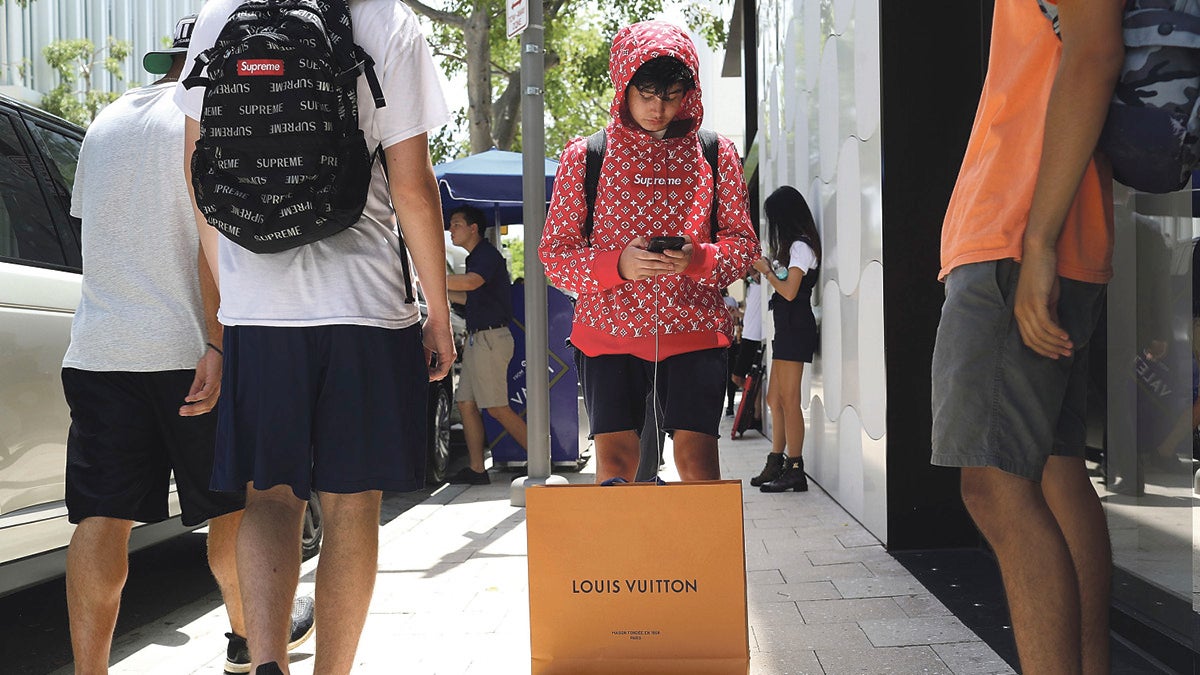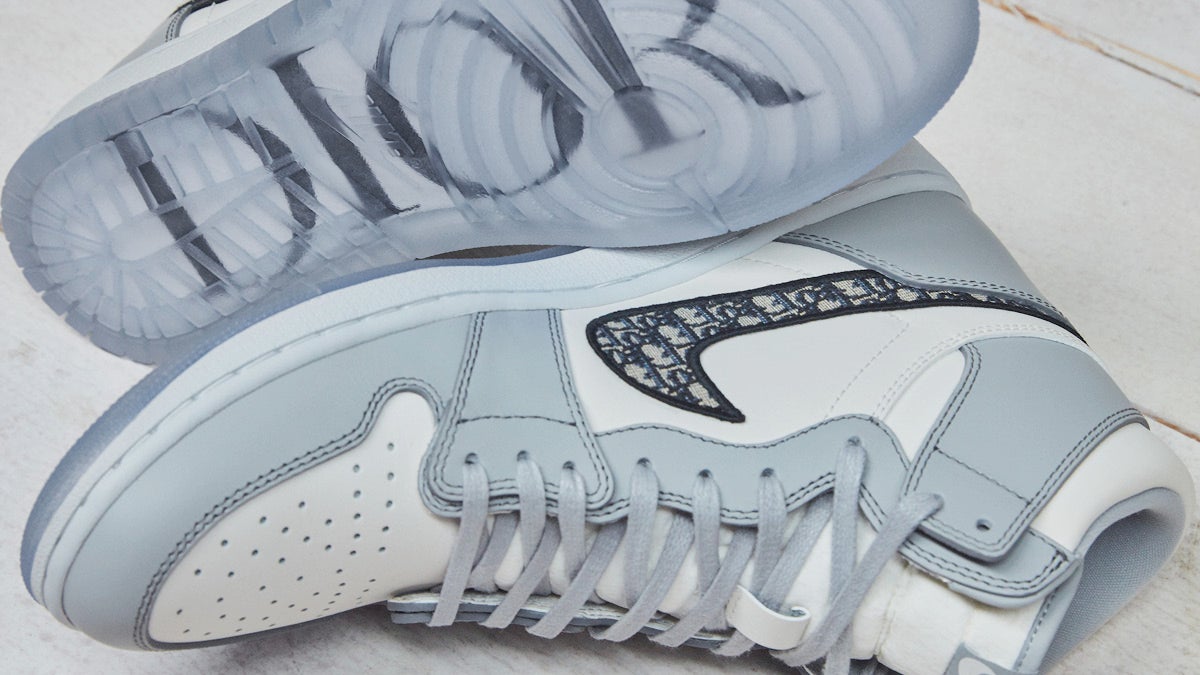
On the face of it, they could hardly be more different. One is the French luxury house with a heritage dating back 150 years and celebrated for its beautifully engineered bags and suitcases bearing a distinctive yet discreet design. The other is a skateboarding label established in New York in 1994 whose bold, provocative designs and great thumping fist of a logo is beloved of “hypebeasts”.
So, when Louis Vuitton announced a creative partnership with Supreme in 2017, the first of a swathe of luxury-streetwear collaborations, luxury market commentators raised an immaculately plucked eyebrow.
What was Louis Vuitton thinking of? Well, a new customer base, for one thing. Despite these understandable misgivings, the pairing, which sent denim jackets and red and white bumbags down the Paris runway, and has since spawned leather jackets, trunks and even slippers sporting logos of both brands, has been phenomenally successful.
This summer the archetypical French luxury brand launched a capsule collection with Nigo, the Japanese streetwear pioneer and founder of A Bathing Ape and Human Made. The Louis Vuitton logo appears on grey crewneck sweatshirts and black zip-up hoodies among various pieces.
Other brands jumped on the streetwear bandwagon
Other luxury streetwear collaborations include Ermenegildo Zegna, the menswear house that combines innovative fabrics with elegant, understated Italian tailoring and Fear of God, beloved of Kanye West and Justin Bieber for its oversized hooded sweatshirts and belted cargo trousers. In July, hundreds queued from 4am outside the London flagship of Dior to pay £1,800 for a pair of Air Jordan 1 OG Dior trainers. Five million people had registered to try and buy the limited-edition trainers, although just 13,000 were manufactured.

In the 12 months to April last year, mentions of luxury and streetwear collaborations on Instagram increased by 25 per cent among influencers’ posts compared to 2016, according to trend forecaster Heuritech.
More widely the trend has inspired exciting new looks, prompted debate within the luxury fashion world about how to address new audiences and boosted sales for many brands. Its disruptive influence can be seen in this year’s autumn-winter shows with a loud, seventies vibe present in collections by Comme des Garcons, Dries Van Noten and Tom Ford among others, featuring daring cuts and bold colours that explode with the energy of streetwear.
Luxury brands search for new audiences
“Luxury streetwear collaborations create newness and a buzz among customers who are always looking for these things,” explains Mario Ortelli, managing director of Ortelli&Co, advisers to the luxury industry. “For luxury brands it’s also an opportunity to innovate with the creation of a capsule collection alongside their main ranges. You reach a new audience, too.
“It’s a very smart way of talking to and recruiting a younger consumer who doesn’t yet have a wallet big enough for your principal collections, but might well do in the future.”
Contrast is an important factor for success. “It works well when you have two brands that would not normally be associated with each other, for example Fila and Fendi, which have a very different approach to design and very different audiences,” he says.
These unlikely pairings have a particular resonance for Chinese customers who accounted for 90 per cent of the global luxury market growth in 2019, reaching 35 per cent of the value of luxury goods sold in the world, according to consultancy Bain & Company. This is more than double the figure for 2010.
It’s a smart way of talking to a consumer who doesn’t yet have a wallet big enough… but might well do in the future
As the luxury market struggles with the fallout of the pandemic, Bain predicts that Chinese consumers will be responsible for more than half of all luxury goods purchases by 2025 when sales are expected to reach €320-330 billion globally.
Online channels and social media
According to Gartner’s Luxury China: Streetwear Insight Report, it was the partnership between high-end luggage manufacturer Rimowa and Virgil Abloh’s Off-White streetwear brand that was responsible for 94 per cent of Rimowa’s engagement on Weibo. The collaboration also delivered the highest daily Baidu Index score for the brand between January 2018 and March 2019.
“Chinese customers prefer extroverted values for luxury, manifested through expressions of extravagance and fun identity statements. This is in stark contrast to the global luxury customer, where traditional values like heritage, craftsmanship and timelessness play a much bigger role,” says Olivier Kuziner, general manager, Asia-Pacific, at Ekimetrics, a data science consultancy.
“Luxury streetwear collaborations are a great way to tap into this desire for extroversion and completely makes sense when you consider the average luxury shopper is much younger in China than in the rest of the world.”
Exclusivity is one of the main drivers of consumer interest in fashion, especially in China, says Christophe Brumby, creative strategy director at Amplify and former global head of marketing at high-end menswear labels including Orlebar Brown.
“As a common denominator between luxury and streetwear, and as both worlds continue to meet and merge, the definition of exclusivity is shifting,” he says. “Although scarcity remains at its heart, luxury traditionally defined exclusivity through price and quality. But streetwear now also defines it through the lens of knowledge and community.”
Has the trend passed its peak? It’s certainly entering a new era, as Abloh recently tweeted: “What we do is called design. It’s not limited to being called ‘streetwear’. Design is design. The moral of the story is beware of whatever box you’re labelled as. Challenge it. Defy it. Do not be defined by it.”

On the face of it, they could hardly be more different. One is the French luxury house with a heritage dating back 150 years and celebrated for its beautifully engineered bags and suitcases bearing a distinctive yet discreet design. The other is a skateboarding label established in New York in 1994 whose bold, provocative designs and great thumping fist of a logo is beloved of “hypebeasts”.
So, when Louis Vuitton announced a creative partnership with Supreme in 2017, the first of a swathe of luxury-streetwear collaborations, luxury market commentators raised an immaculately plucked eyebrow.
What was Louis Vuitton thinking of? Well, a new customer base, for one thing. Despite these understandable misgivings, the pairing, which sent denim jackets and red and white bumbags down the Paris runway, and has since spawned leather jackets, trunks and even slippers sporting logos of both brands, has been phenomenally successful.
